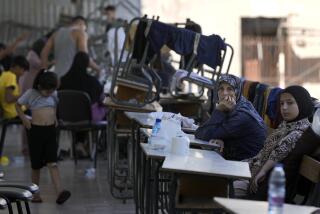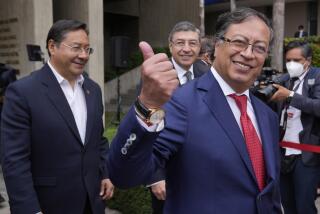The voice of Libya’s rebellion is up and spinning
Reporting from Benghazi, Libya — Salah from central Benghazi was on the line, sounding indignant.
Why was Benghazi so filthy? Was everyone so busy rushing to the front to fight that they couldn’t clean up their own city?
Inside a makeshift sound studio, radio host Khalid Ali wearily rubbed his eyes. Voice of Free Libya radio — 98.9 on your FM dial — had just opened its caller lines for another round of hectoring.
“If they’re not asking about garbage, they’re complaining that people fire guns into the air all night long,” Ali said, tapping his cellphone, which he holds next to a worn microphone when taking listeners’ calls on the air. “Everybody has an opinion.”
Seven weeks into the rebellion, Voice of Free Libya is a centerpiece of the emerging rebel media, public relations and propaganda effort in eastern Libya.
The station airs revolutionary music, pop songs, rebel-themed poetry — and calls from cranky citizens irritated by the chaos stirred up by the rebellion. It also provides news reports from the front by unpaid amateur reporters, plus caller updates on casualties, missing persons, rocket attacks and funerals for shuhada, or “martyrs,” killed by Moammar Kadafi’s forces.
Mohammed G. Fannoush, the urbane former national librarian who runs the rebels’ expanding media empire, acknowledges that it is a mouthpiece for the rebel leadership. But he also says the rebels have opened up information streams and public dialogue that didn’t exist under Kadafi.
“Anyone under 50 doesn’t know anything about their own country, because Kadafi has controlled the media since 1969,” Fannoush said inside a former Kadafi regime building, where a two-story mural of the dictator has been ripped from the facade. “If you read one Kadafi newspaper, you’d read them all.”
You might also say that if you’ve heard one rebel media outlet, you’ve heard them all. A common theme is the heroism of the shabab, the young rebel fighters, and the purity and legitimacy of the rebel cause. Kadafi is portrayed as the devil, along with his grasping sons and scheming henchmen in Tripoli.
It’s not exactly fair and balanced media. In fact, as Fannoush helpfully pointed out, there are four inviolate rules of coverage on the two rebel radio stations, TV station and newspaper:
• No pro-Kadafi reportage or commentary (at least until the tyrant in Tripoli is deposed).
No mention of a civil war. (The Libyan people, east and west, are unified in a war against a totalitarian regime.)
No discussion of tribes or tribalism. (There is only one tribe: Libya.)
No references to Al Qaeda or Islamic extremism. (That’s Kadafi propaganda.)
As the rebels fight Kadafi’s forces, they are also battling a Tripoli propaganda machine that controls radio, TV, newspapers and public dialogue in western Libya. The opposition’s Western Hemisphere-educated, English-speaking spokesmen spin and cajole international reporters, who are free to roam eastern Libya while their colleagues in Tripoli are hemmed in by regime minders.
When the Kadafi government jammed the signals of the new rebel TV station here during its launch, the Persian Gulf nation of Qatar stepped in with a temporary channel.
In late February, after the Kadafi government cut Internet service in the east, the rebels recruited a posse of young, tech-savvy volunteer hackers. They pounded away on laptops inside a darkened room in Benghazi’s graffiti-streaked courthouse until they had built rudimentary Web connections.
Today, there is Wi-Fi inside the grimy courthouse complex, and a “media center” where journalists use the wireless connection to file their reports. To keep out hordes of young Libyans starved for Internet access, volunteer guards in red berets limit access to “accredited journalists” — anyone who manages to get hold of an official rebel press badge. (At last count, they numbered 1,000-plus.)
The six-page rebel newspaper, Voice of the Shabab, is distributed free at the courthouse, where the opposition national council meets.
A recent edition carried an editorial on the goals of the revolution: democracy, equality, free speech, freedom from corruption, and better education and healthcare. The issue featured photos of shabab racing in gun trucks to the front (panicked retreats not pictured) or marching in flag-waving street demonstrations.
There was a public service announcement: “Please don’t reveal the locations of military bases or radio and TV stations.”
And there was a response to some readers’ demands that someone paint over the revolutionary graffiti defacing most downtown buildings: That won’t happen, the paper said. Graffiti are the voice of the people.
Some of the graffiti are spray-painted in English — an appeal to international journalists:
“Be gone Ghadafy.” “No for extremism.” “Go out Moammar.” “Libya is free.” “We don’t want an autocratic tyrant.”
And this plea: “Everybody is watching us. Be brave. Use a nice behavior.”
The rebel message is also spread by vendors selling the red, black and green pre-Kadafi Libyan flag used by the rebels and bumper stickers with revolutionary slogans. They also offer flag decals, buttons, lapel pins and hats. Some vendors sell the French tricolor, a nod to France’s diplomatic recognition of the rebel government and its leading role in airstrikes against Kadafi’s fighters.
In a chilly second-story room at the courthouse, young artists churn out caricatures of Kadafi and posters lampooning the Libyan leader, especially his unruly hair and sartorial flourishes. Some posters feature him as a monkey, rat or donkey. Others depict him with horns or trailed by houseflies, often clutching bags of loot.
A few posters depict the Star of David, reflecting the pervasive belief among rebels that Kadafi’s mother was Jewish. It is not meant as a compliment.
Rebel propaganda isn’t confined to graffiti and posters. Ibrahim Bugaighis, a bank employee and rebel council volunteer, has adorned his silver Mitsubishi sedan with gruesome photos of government fighters killed by allied airstrikes.
“You could say this is my Facebook page,” he said.
A few miles away, at the rebels’ AM radio station, a cramped two-man studio has been built from plywood and Plexiglas in a dilapidated building that once housed the regime’s transmitting station. The government’s modern radio studio nearby was burned and looted during street battles in February.
Inside the jury-rigged studio, a volunteer technician, Essam Ali, monitored the day’s broadcast on AM 675 as a red “ON AIR” sign blinked. He sat before a scuffed, pre-digital-era mixing board and wore a 1970s-era headset.
Another volunteer, Abdullah Haneid, a burly, bearded fellow who quit his job as a government radio engineer two years ago, supervised the shoestring operation.
“We try to assure the people that we are all connected, that there is order and that we have a plan,” Haneid said. “This is an important job for us.”
Over the air, an imam railed against Libyans who have sought foreign military intervention against Kadafi. Good Muslims should fight jihad on their own, he instructed.
As the broadcast droned on, Haneid showed a visitor a storage area next to the little studio. Inside was a dusty old transmitter.
It broadcast the very first speech by a young army officer after he seized power in a 1969 coup, Haneid explained. His name was Moammar Kadafi.
“This carried the voice of the 1969 revolution,” Haneid said with satisfaction. “Now here we are in the same place, spreading the word of our own revolution.”
More to Read
Sign up for Essential California
The most important California stories and recommendations in your inbox every morning.
You may occasionally receive promotional content from the Los Angeles Times.











